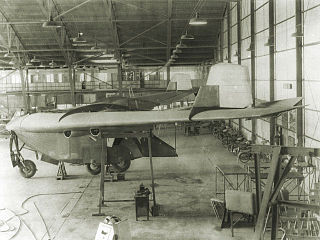Related Research Articles

The General Aircraft GAL.42 Cygnet II was a 1930s British single-engined training or touring aircraft built by General Aircraft Limited at London Air Park, Hanworth.

The Parnall Heck was a 1930s British four-seat cabin monoplane built by Parnall Aircraft Limited at Yate, Gloucestershire. Originally a Hendy design, few were built. It combined the strength and comfort of a cabin aircraft with the speed of a racer.

The Bölkow Bo 207 was a four-seat light aircraft built in West Germany in the early 1960s, a development of the Klemm Kl 107 built during World War II.

The DINFIA IA 38 was a 1960s Argentine four-engine experimental tailless transport aircraft, designed under the direction of Reimar Horten and based on the German Horten Ho VIII project and built by the DINFIA.

The Siebel Si 202 Hummel ("Bumble-bee") was a German light sportsplane of the late 1930s. It was an angular low-wing monoplane, which could be powered by a variety of small engines.
The Yakovlev Yak-58 is a small, multi-role utility transport and business aircraft. The aircraft features a pusher engine and twin boom tail. It saw limited production in the late 1990s.
The Portsmouth Aerocar was a British light utility aircraft design of the late 1940s. It was intended to be an aircraft that could be used for a variety of tasks including transport "mobile office" but only one prototype was built being scrapped in 1950.
The Fane F.1/40 was a 1940s British Air Observation Post aircraft design by Captain Gerald Fane's Fane Aircraft Company.

The Stearman-Hammond Y-1 was a 1930s American utility monoplane built by the Stearman-Hammond Aircraft Corporation and evaluated by the United States Navy and the British Royal Air Force.

The Praga E-210 was a four-seat, twin-engined touring aircraft built in Czechoslovakia in the late 1930s. It had an unusual pusher configuration. Its tail unit and undercarriage were modified significantly before World War II and after the war a more powerful version designated E-211 was flown.

The SNCAO 30 was a French single-engined monoplane flying boat two-seat trainer. Although it was ordered into production for the French Navy, only two prototypes were built.

The Gwinn Aircar was a single-engined biplane with a cabin for two, designed in the US as a safe and simple private aircraft. Lacking a rudder, it had several unusual control features as well as an early tricycle undercarriage. Development was abandoned after a crash in 1938.
The ICA IS-23 was a single-engined high-wing monoplane with STOL capability that was built in Romania in the 1960s. It was developed into the similar ICA IS-24.
The Mansyū Ki-98,, was a Japanese ground-attack aircraft proposed by Mansyū during World War II for use by the Imperial Japanese Army Air Force. The still unassembled components of the first prototype were deliberately destroyed before Japan surrendered.

The SAIMAN LB.2 was an unconventional Italian two seat cabin side by side sport aircraft designed around 1937, with a single pusher configuration engine, twin tail booms and an early tricycle undercarriage.

The Waterman Arrowbile was a tailless, two-seat, single-engine, pusher configuration roadable aircraft built in the US in the late 1930s. One of the first of its kind, it flew safely but generated little customer interest, and only five were produced.

The Fieseler F 4 was developed, built and flown as a two-seat sports and travel aircraft at the Fieseler Flugzeugbau.
The WNF Wn 16 was an Austrian experimental aircraft built near the start of World War II to test the properties of the then-new tricycle undercarriage arrangement.

The Couzinet 20 was a low power, three-engined aircraft designed in France in 1929 for postal duties, though it could have been configured to carry three passengers or as a medical transport. Variants flew with three different engines but only two airframes were completed.
The SCAL FB.30 was a French twin boom, pusher configuration, two seat civil sport and touring aircraft designed by Antoine Bassou in the mid-1930s. Three, with different engines, were built and flown.
References
Notes
- 1 2 3 Grey 1972 , pp. 18c–19c
- 1 2 "Combined Virtues". Flight . 12 May 1938. p. 479. Archived from the original on 1 January 2015.
- ↑ "British Civil Aviation: The Smaller Types: Arpin". Flight . 25 November 1937. p. 515. Archived from the original on 5 March 2016.
- 1 2 Jackson 1959 , pp. 407
- ↑ "To-day's Light Aeroplanes: Arpin". Flight . 7 September 1939. p. 218. Archived from the original on 9 August 2017.
- ↑ CAA registration document for G-AFGB
- ↑ Meaden, Arthur (1990). "The Arpin A-1 "Safety Pin"". Archive. Air-Britain. 1999 (3): 83–86. ISSN 0262-4923.
- ↑ "Feedback: The Arpin A-1 "Safety Pin"". Archive. Air-Britain. 2000 (2): 67. 2000. ISSN 0262-4923.
- ↑ Estimated performance figures
Bibliography
- Grey, C.G. (1972). Jane's All the World's Aircraft 1938. London: David & Charles. ISBN 0-7153-5734-4.
- Jackson, A.J. (1959). British Civil Aircraft 1919-59. Vol. 1. London: Putnam Publishing.